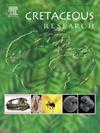哥伦比亚瓦兰吉尼亚晚期大型上龙的证据
IF 1.7
3区 地球科学
Q1 GEOLOGY
引用次数: 0
摘要
下白垩纪上龙的化石记录,特别是来自Valanginian的化石记录,在全球范围内仍然知之甚少,这阻碍了在更广泛的时间框架内重建它们的进化和古地理分布的努力。在这里,我们描述了一个分离的颈椎体(最大直径14厘米),属于brachacheniinae gen. et sp. indet的上龙。来自哥伦比亚萨帕托卡的下白垩纪(上瓦兰吉尼亚)Rosa Blanca组。Rosa Blanca组中大型brachacheniines的存在表明,这些大型上龙是早白垩纪时期居住在冈瓦纳西北边缘的丰富多样的动物群的一部分,并将其在南美洲北部的记录从巴雷米亚延伸到晚瓦兰吉尼亚。这些上龙有可能成为低纬度浅海环境食物链中的顶级捕食者。这一发现为原加勒比海地区早白垩世海生爬行动物的分类和年代地层格架提供了新的数据。本文章由计算机程序翻译,如有差异,请以英文原文为准。
Evidence of large pliosaurids in the late Valanginian of Colombia
The fossil record of Lower Cretaceous pliosaurids, particularly from the Valanginian is still poorly known globally, hindering efforts to reconstruct their evolution and palaeogeographical distribution within a broader time frame. Here, we describe an isolated cervical centrum (14 cm maximum diameter) of a pliosaurid belonging to a Brachaucheniinae gen. et sp. indet., from the Lower Cretaceous (upper Valanginian) Rosa Blanca Formation in Zapatoca, Colombia. The presence of large brachaucheniines in the Rosa Blanca Formation suggests that these large pliosaurids were part of the abundant and diverse fauna that inhabited the northwestern margin of Gondwana during the Early Cretaceous and extends their record in northern South America from the Barremian to the late Valanginian. These pliosaurids potentially acted as top predators in the food chain of lower latitude shallow marine environments. This discovery contributes new data to the taxonomic and chronostratigraphic framework of Early Cretaceous marine reptiles from the Proto-Caribbean domain.
求助全文
通过发布文献求助,成功后即可免费获取论文全文。
去求助
来源期刊

Cretaceous Research
地学-地质学
CiteScore
4.10
自引率
19.00%
发文量
235
审稿时长
12 weeks
期刊介绍:
Cretaceous Research provides a forum for the rapid publication of research on all aspects of the Cretaceous Period, including its boundaries with the Jurassic and Palaeogene. Authoritative papers reporting detailed investigations of Cretaceous stratigraphy and palaeontology, studies of regional geology, and reviews of recently published books are complemented by short communications of significant new findings.
Papers submitted to Cretaceous Research should place the research in a broad context, with emphasis placed towards our better understanding of the Cretaceous, that are therefore of interest to the diverse, international readership of the journal. Full length papers that focus solely on a local theme or area will not be accepted for publication; authors of short communications are encouraged to discuss how their findings are of relevance to the Cretaceous on a broad scale.
Research Areas include:
• Regional geology
• Stratigraphy and palaeontology
• Palaeobiology
• Palaeobiogeography
• Palaeoceanography
• Palaeoclimatology
• Evolutionary Palaeoecology
• Geochronology
• Global events.
 求助内容:
求助内容: 应助结果提醒方式:
应助结果提醒方式:


